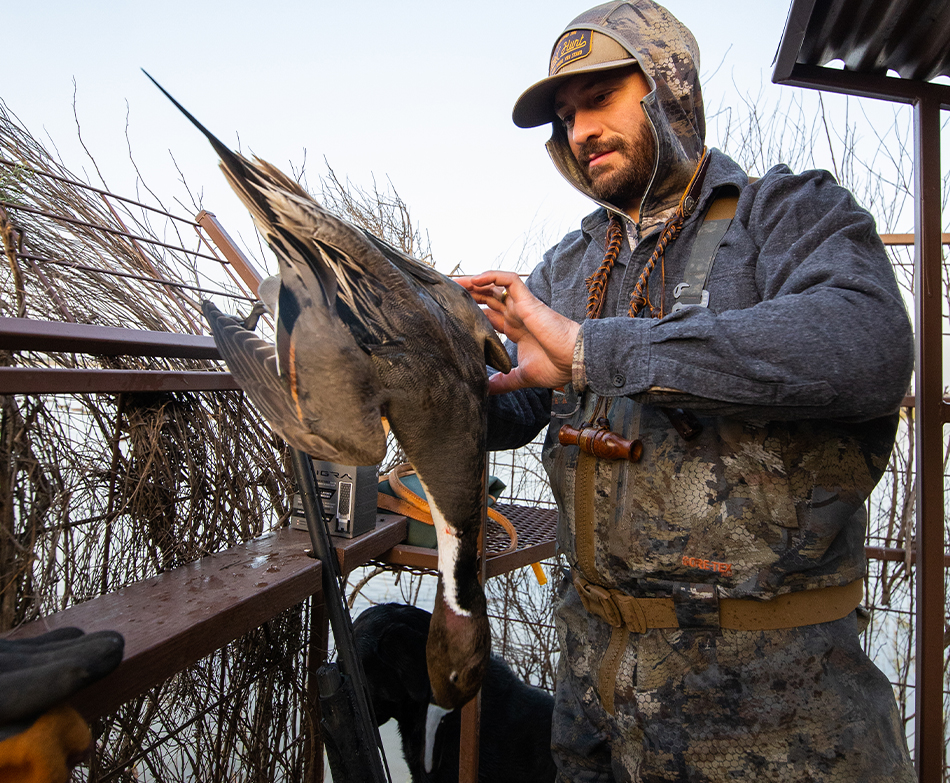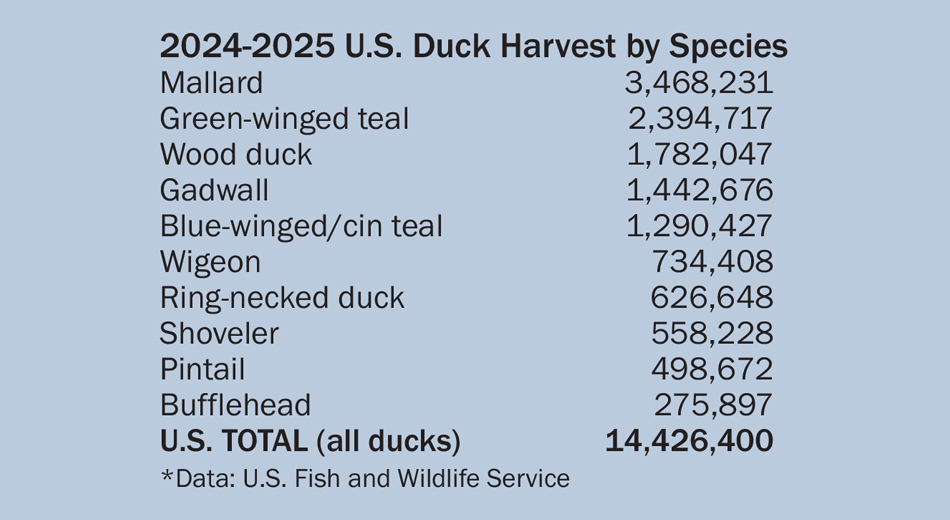
Waterfowl Hunter Numbers Drop
Reports reveal slight decrease from prior season, duck harvest also dips
The number of active waterfowl hunters in North America continues to decline, following a decades-long trend.
According to the Migratory Bird Hunting Activity and Harvest Report issued annually by the U.S. Fish and Wildlife Service, 1.26 million people actively hunted ducks and geese in the United States during the 2024-2025 season. The USFWS estimate shows a 2.5% decrease in active waterfowl hunters from the 2023-2024 season.
A separate report from the Canadian Wildlife Service puts the number of active resident hunters at 127,082 in 2024, a 1.4% decline from the previous year and Canada’s second-lowest number of waterfowl hunters in data records beginning in 1966.
The number of North American waterfowl hunters peaked in the 1970s, with 505,681 Canadian hunters in 1978 and 2.02 million U.S. hunters in 1970-1971.
So, who’s still hunting ducks and geese, and where?
In the United States, Texas has the most active waterfowlers with 119,700, with Arkansas firmly in second at 79,400. Wisconsin, Minnesota, and Louisiana round out the Top 5. In Canada, Ontario leads with 44,052 resident waterfowl hunters, with Quebec next at 27,216. That means 56% of Canada’s resident waterfowlers live in Ontario and Quebec. Alberta, Newfoundland, and Saskatchewan complete Canada’s Top 5.
Harvest Stats
The USFWS report estimates hunters shot 14.34 million ducks in the United States during the 2024-2025 season, a 2.2% decrease from the previous year’s estimate of 14.76 million.
Arkansas hunters took 1.42 million ducks, the most of any state. Louisiana hunters shot 1.25 million ducks, with California next with 1.11 million. Texas hunters harvested 1.1 million ducks, while Minnesota ranked fifth at 655,700.
California hunters averaged 21.9 ducks per hunter, while Louisiana hunters shot 21.2 ducks. The average Arkansas hunter shot 18.8 ducks. Pennsylvania hunters have the dubious distinction of the least ducks killed per hunter, averaging only 4.4 last season.

The most popular duck in North America—the mallard—tops all other species in harvest. U.S. hunters shot 3.47 million last season. Arkansas led with 530,183 mallards, but the next states on the list might surprise people. Oklahoma was second with 201,683, while Missouri ranked third with 187,251. Tennessee was fourth with 180,965, followed by North Dakota at 164,401. Green-winged teal at 2.39 million were the second-most-commonly harvested duck, with wood ducks third at 1.78 million. Gadwall were fourth, and blue-winged/cinnamon teal fifth. Among diving ducks, ring-necked ducks ranked 7th at 626,648, with buffleheads 10th at 275,897.
Green-winged teal at 2.39 million were the second-most-commonly harvested duck, with wood ducks third at 1.78 million. Gadwall were fourth, and blue-winged/cinnamon teal fifth. Among diving ducks, ring-necked ducks ranked 7th at 626,648, with buffleheads 10th at 275,897.
While U.S. hunters shot fewer ducks than the previous year, the goose harvest increased 2.4% to 3.48 million during the 2024-2025 season. Of those, hunters shot 2.37 million Canada geese, 416,769 white-fronted geese, and 381,471 snow/blue geese, 235,793 cackling geese, 64,428 Ross’s geese, and 14,461 brant.
California hunters shot 276,100 geese, the highest total of any state. California’s take of 97,174 snow/blue geese also led the country, as did the state’s harvest of 22,443 Ross’s geese. California hunters harvested 89,534 white-fronted geese, second only to Arkansas hunters who shot 134,741. Arkansas was third overall in goose harvest with 256,400 total geese. Kansas hunters ranked second with 258,200 geese, averaging an impressive 13.6 geese per hunter.
North Dakota hunters shot 184,400 geese, with Michigan closing out the Top 5 with 169,400 total geese. Michigan hunters harvested the most Canada geese, with 167,809 honkers.
Oklahoma hunters took 42,432 cackling geese, the highest total for that species, with Texas at 40,845 and Kansas at 39,943 close behind.
New Jersey led in brant harvest with 2,535, while Alaska was next at 1,978.
Flyway Snapshots
In the United States, the Atlantic Flyway had 287,100 active waterfowlers, or 22.8% of the nation’s duck and goose hunters. Atlantic hunters shot 2.41 million ducks, representing 16.7% of the total U.S. harvest, and 579,100 geese equaling 16.6%. Wood ducks were the most taken duck, with the flyway’s total of 579,417 woodies making up 32.5% of the country’s harvest. The Atlantic Flyway led in black duck harvest with 149,448, or 79.8% of the total. Atlantic hunters also shot 84.3% of the country’s scoters. Florida hunters accounted for nearly half of the mottled duck harvest and led all states with 140,058 ring-necked ducks. The Mississippi Flyway had 512,200 waterfowl hunters, or 40.7% of the total. They shot 6.4 million ducks, or 44.4%, and 1.38 million geese, or 39.7%. Mississippi Flyway hunters accounted for 51% of the U.S. mallard harvest, 60.7% of the wood ducks, and 49.2% of blue-winged/cinnamon teal. In addition, the flyway’s harvest of 1.38 million Canada geese was 58.2% of the total for the species. Mississippi Flyway hunters also shot the most shovelers and pintails. Arkansas was the top state in the nation for mallards and gadwalls, while Louisiana led in wood duck and canvasback harvest and ranked second for green-winged teal and blue-winged/cinnamon teal.
The Mississippi Flyway had 512,200 waterfowl hunters, or 40.7% of the total. They shot 6.4 million ducks, or 44.4%, and 1.38 million geese, or 39.7%. Mississippi Flyway hunters accounted for 51% of the U.S. mallard harvest, 60.7% of the wood ducks, and 49.2% of blue-winged/cinnamon teal. In addition, the flyway’s harvest of 1.38 million Canada geese was 58.2% of the total for the species. Mississippi Flyway hunters also shot the most shovelers and pintails. Arkansas was the top state in the nation for mallards and gadwalls, while Louisiana led in wood duck and canvasback harvest and ranked second for green-winged teal and blue-winged/cinnamon teal.
The Central Flyway had 291,500 active hunters, or 23.1%. They shot 3.18 million ducks or 22%, while 986,600 geese equaled 28.3% of the U.S. harvest. The Central finished second in harvest of mallards, gadwalls, wigeon, and green-winged teal. Led by Texas, the Central Flyway accounted for 125,138 redheads, which was 57.7% of the harvest.
At 162,900 hunters, the Pacific Flyway had only 12.9% of the country’s waterfowlers. However, they shot 2.39 million ducks or 16.6%, and 535,000 geese, a mark of 15.4%. Pacific hunters shot 363,874 wigeon, 49.5% of the total U.S. harvest. The flyway ranked second in harvest of shovelers and pintails. California hunters shot 86,358 pintails, more than double the total taken in any other state.
Canada Stats Incomplete
Harvest statistics for the 2024 season were not yet available, but a quick snapshot of 2023 numbers showed 874,613 geese and 776,610 ducks were taken by 145,847 licensed hunters, including 16,902 non-Canadians.
In 2023, hunters shot 353,464 mallards, 53,689 black ducks, 53,572 green-winged teal, and 51,181 pintails in Canada. Hunters took 619,883 Canada geese, 141,199 snow/blue geese, 81,270 whitefronts, and 32,214 Ross’s geese.
Saskatchewan hunters led all provinces with 184,632 ducks and 281,469 geese. Alberta was second in goose harvest with 194,059, but third in ducks at 134,205. Ontario was second in ducks with 176,364 and third in geese at 150,291. Quebec ranked fourth with 102,027 ducks and 135,360 geese. —Paul Wait
Paul Wait is communications director and Delta Waterfowl historian at Delta Waterfowl. Article originally published in Delta Waterfowl's winter 2025 magazine.
Join Delta Waterfowl to receive our member-exclusive magazine and eNewsletter—packed with the latest in duck research, expert tips on duck dogs, hunting insights, conservation updates, and more.
Your membership helps you stay informed while supporting the future of waterfowling. Join now: Become A Member.
